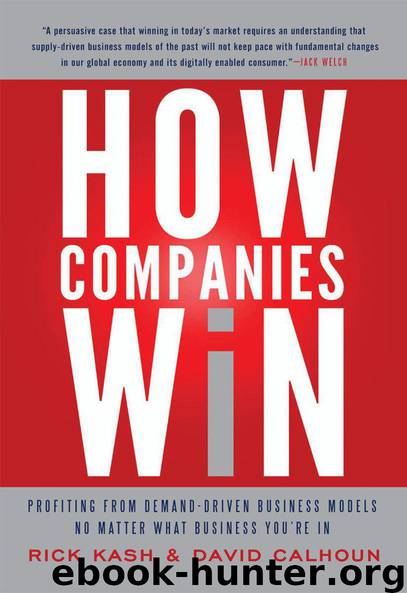How Companies Win by Kash Rick & Calhoun David

Author:Kash, Rick & Calhoun, David [Calhoun, David]
Language: eng
Format: epub
Publisher: HarperCollins e-books
Published: 2010-10-11T14:00:00+00:00
THE VALUE OF FAILURE
It was marketing guru Regis McKenna who famously said that Silicon Valley, generally regarded as the most innovative business community on earth, is most defined by failure”25 By this, he meant that it takes a large number of failed products, services, companies, and initiatives to create that handful of successful innovations that drive the technology revolution forward. And because of that, Silicon Valley has developed a culture that, if it doesn’t reward failure, certainly respects honorable failures and tries to learn from them.
As the history of Silicon Valley has shown, this appetite for risk despite the potential for failure is a powerful process for the creation of radical new products and fast-moving new industries. But it is a brutal process, too, with a high mortality rate among young companies.
For individual companies, this is a hard way to live—and die. What established companies want is strong, continuous growth and healthy, defensible markets. And yet, too often, they pursue the Silicon Valley model of innovation: perpetually chasing that new “home run” product, the game changer that will secure the company’s fortunes forever.
It doesn’t work. Perpetual breakthrough innovation is all but impossible, even in companies built specifically around that strategy (as we’ll see later in the story of Motorola). If you want to build a company that wins and lasts, you need a strategy that combines continual innovation that is both targeted toward, and refined by, the people who will use that innovation. That means enlisting those customers in product design via crowdsourcing and other forms of community-based design, user groups, shared code and open systems, and previewing products while still in their alpha and beta stages. It also means providing them with entrepreneurial opportunities—such as the Apple iStore—that enable them to bring their own intellectual capital to bear on improving the total experience of your product or service. And it means soliciting the help of this army of supporters for everything from sales and marketing, to early warning about competitive threats, to aftermarket products, service, and support.
It was precisely because of their high mortality rate that Silicon Valley companies recognized first these new roles for their customers. Customer participation has proven to be the crucial competitive advantage for Apple and Google, among others—and it is the very basis for the existence of companies like Twitter, Craigslist, eBay, Wikipedia, and YouTube.
Not only does customer participation in the innovation process massively force-multiply the brainpower brought to the task (for free!) but, because these consumers are in effect designing for themselves, what they produce is almost always perfectly targeted. And isn’t this exactly what you are looking for in your own innovation strategy?
Download
This site does not store any files on its server. We only index and link to content provided by other sites. Please contact the content providers to delete copyright contents if any and email us, we'll remove relevant links or contents immediately.
Hit Refresh by Satya Nadella(9082)
The Compound Effect by Darren Hardy(8869)
Change Your Questions, Change Your Life by Marilee Adams(7683)
Nudge - Improving Decisions about Health, Wealth, and Happiness by Thaler Sunstein(7655)
The Black Swan by Nassim Nicholas Taleb(7054)
Deep Work by Cal Newport(6965)
Rich Dad Poor Dad by Robert T. Kiyosaki(6510)
Daring Greatly by Brene Brown(6473)
Principles: Life and Work by Ray Dalio(6296)
Playing to Win_ How Strategy Really Works by A.G. Lafley & Roger L. Martin(6079)
Man-made Catastrophes and Risk Information Concealment by Dmitry Chernov & Didier Sornette(5952)
Digital Minimalism by Cal Newport;(5702)
Big Magic: Creative Living Beyond Fear by Elizabeth Gilbert(5675)
The Myth of the Strong Leader by Archie Brown(5456)
The Slight Edge by Jeff Olson(5376)
Discipline Equals Freedom by Jocko Willink(5336)
The Motivation Myth by Jeff Haden(5174)
The Laws of Human Nature by Robert Greene(5080)
Stone's Rules by Roger Stone(5051)
